#multidisciplinary degree
Explore tagged Tumblr posts
Text
and now i'm hung up on the song i hate it here. double listen #3. it reminds me of my own mind and a poem i wrote a few years ago. also a short story i read and analyzed recently.
#angel speaks#i hate it here#taylor swift#ts#ttpd#ttpd anthology#the tourtured poets department#the anthology#multidisciplinary degree#english degree
1 note
·
View note
Text
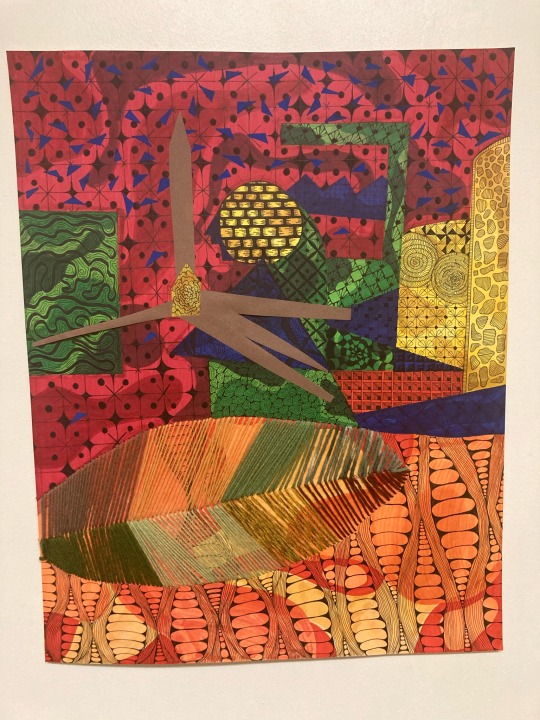
“Crying from the Ceiling to the Floor” (2023)
Sharpie, Alcohol Marker, Micron, Construction Paper Collage, Yarn.
#art#my art#artists on tumblr#small artist#traditional art#art student#art college#college#art school#art degree#abstract aesthetic#abstract art#abstract#collage#yarn#crafts#multidisciplinary#multidisciplinary art#multidisciplinary Artist#mixed media#mixed media art#mixed media artist#multi media#multi media art#multi media artist
4 notes
·
View notes
Text
Sokka's Master
pleasebegoodpleasebegoodpleasebegoodpleasebegoodpleasebegood

Strange choice of master but we'll see where this goes.
The meteor shower animation is quite meditative. I wouldn't mind it as a screensaver.
How to describe something exceptional to your blind friend: "You've never not seen anything like this." It's amazing the quality put into even the tiniest of throwaway jokes.
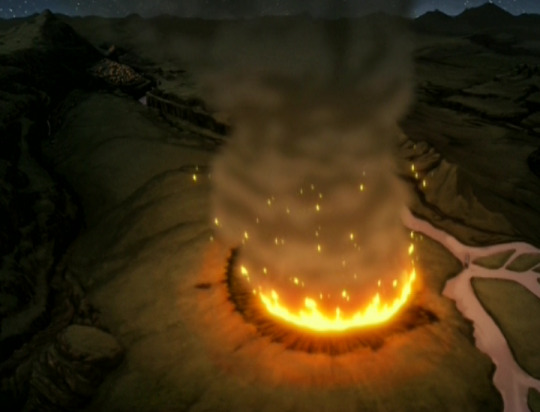
Are meteor strikes flammable?
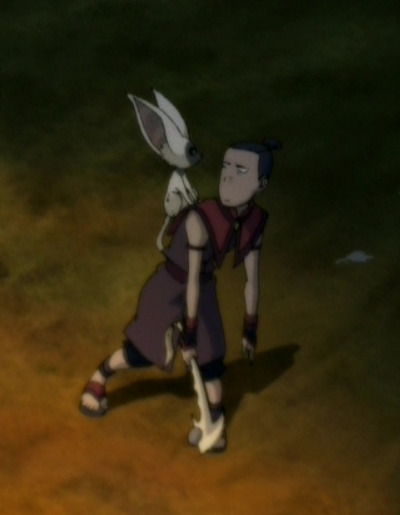
I love how whenever Sokka's disappointed he gets noodle arms. A surprisingly consistent characterisation.
Momo butt skate.
Iroh. The fuck?
ok. So he's playing a part for the guards. Why?

Pretty.
Funny to think about, but as a former WWE character, Toph's probably had more hero worship than the Avatar.
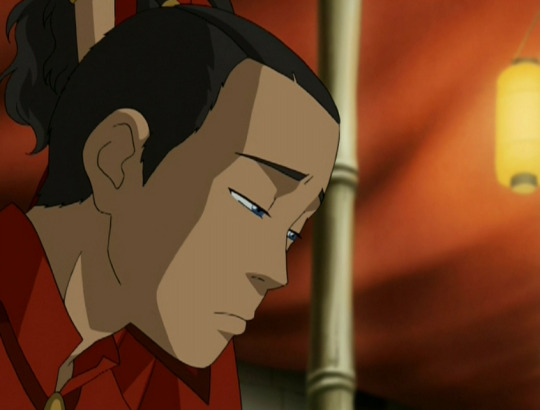
Lots to say about this! First, I stand corrected! i honestly thought that Sokka would be immune to this specific insecurity by virtue of him not being a bender. I was wrong! Second, I love how, as soon as Sokka expresses that he feels that he isn't as talented as the rest of them, the others respond by listing his actual, invaluable talents, without which the group would be completely at sea. They don't respond with "no you're perfect!" they respond with "no one can read a map like you can" and how he keeps their spirits up with jokes. They're not using false praise. They are using specific facts. I love that an episode that looks like it's going to deal with a character feeling down on themselves establishes from the get go that the character is invaluable, actually. So often, the 'low self esteem stock episode' puts the affirmation of the character's value at the end. Which means the viewer spends the whole episode being convinced that the character in question might actually be useless. Here, we're told from the start that the character is invaluable - the problem is that they do not perceive themselves to be so. Quite on the nose for a show that deals so much with identity.
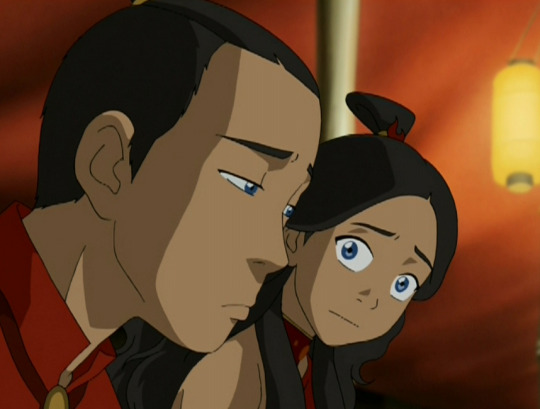
OMIGOD IT GETS BETTER!!!!!!!!!!
Validating Katara sweeps in and a) validates his feelings, while b) clearly explaining that his self-perception is not in line with how the others see him, which c) doesn't invalidate a) !!!!
Katara has such emotional intelligence when she chooses to use it.
Nuanced intelligent discussion of the complexities of emotions and self-perception in a Sokka episode I am so happy I am blessed the gods are shining on me today I'm sitting here twirling my hair and swinging my feet and doodling hearts on the corner of my journal
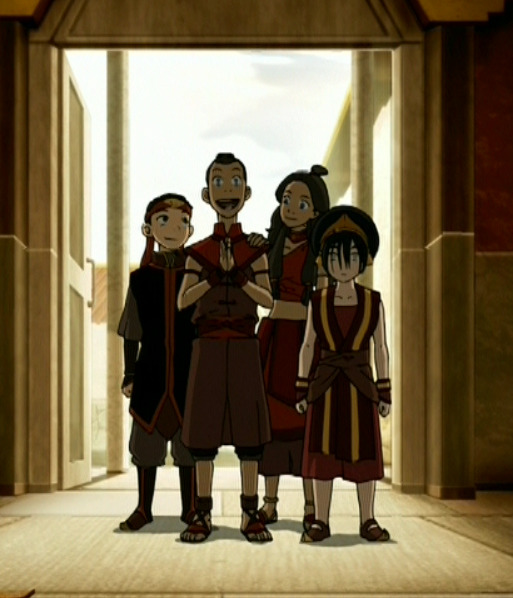
SHOPPING!!!!!
btw that's the same face he makes when he says SUKI!!!
"Reinvigorate my battling" this boy. just. this boy.
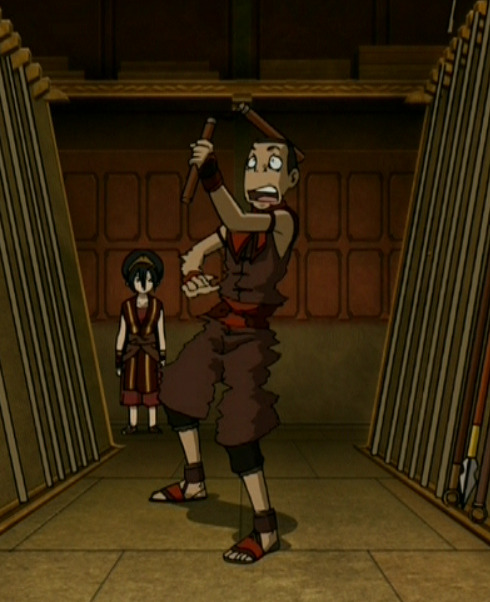
He lasted a lot longer than I would have with nun chucks.

Aang the Happy Meal toy.
Some say that Halberd is still spinning today.
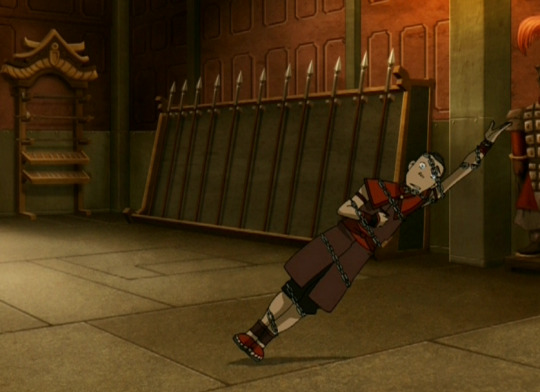
Ladies and Gentlemen, I present: the 45 degree Sokka.
Some Foley artist had the time of their life with this weapons sequence.
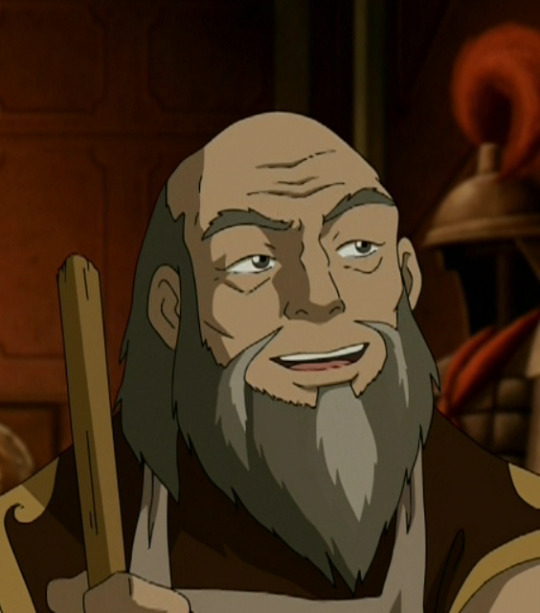
Why thank you for that exposition, Mr. Exposition. Now walk away and we'll never see you again.
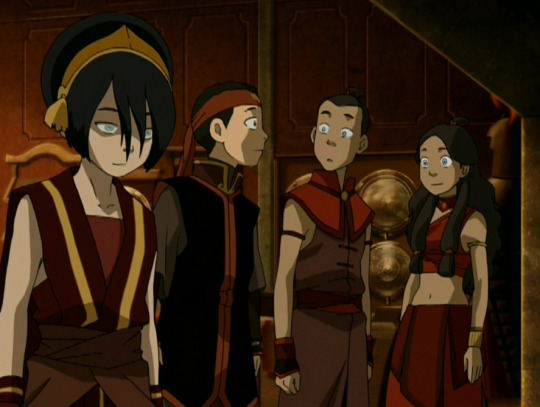
Toph does NOT move ONCE this whole scene and it's ever so slightly freaking me out.
Toph tells you she learned from Badgermoles and no one wants to discuss this further?!? We're going to gloss over that?
So this episode has a training montage theme.
Sokka goes freestyle on those door knockers.
That's one hell of a castle. Must be dark in there though. Tiny windows.

Which explains the several hundred candles. This show. Set up with one hand; slam dunk with the other.
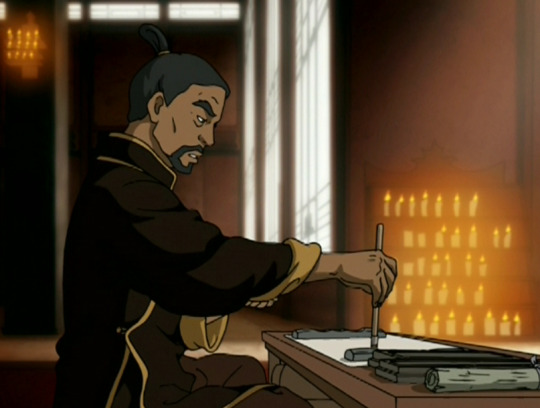
This guy's reciting Sokka's s1 introduction on Kyoshi Island.
Sokka: Actually. I am a dumb. The Master: Sold.

The face of someone who is definitely picking up what you're putting down.
It's been ages since I watched the episode, but is some of what the Master saying here about swords an echo of what Zuko says to the kid in Zuko Alone when he's decapitating sunflowers?

A Sokka-less Gaang. Depressing and they know it.
The way Katara's voice actor says "oh everyone's a critic" is gold.
Multidisciplinary education vs. kid who's never been within a mile of the box he's being told to think outside of. Fight!
Yikes that was a meaty hit. Does Sokka have a nose left?
They're wearing beehives on their heads.
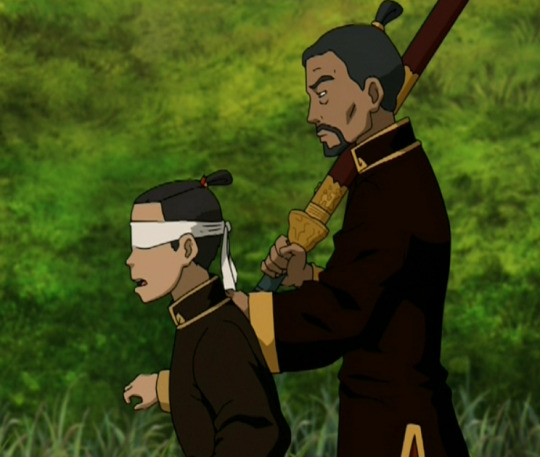
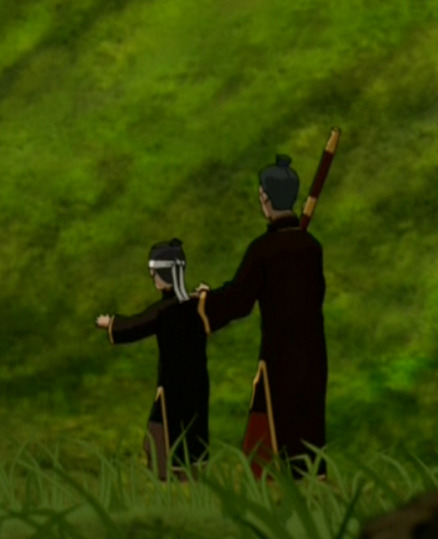
Was Sokka always this short?

The greens in this episode are such a delight.
The way he says "I'm finished!" Sounds like "Am finished" and you can actually hear the smiley emoji he throws in.
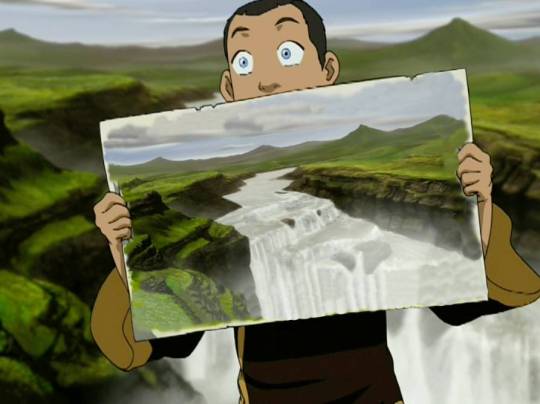
He's good.
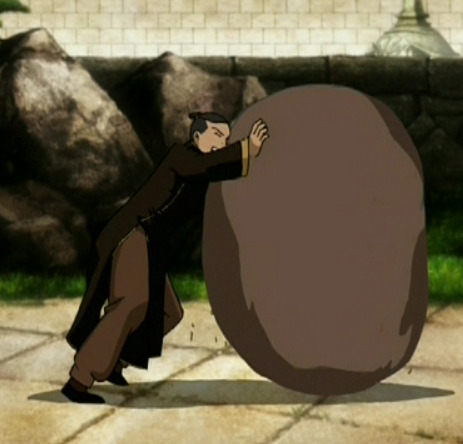
What do they FEED him?
Sokka's voice actor had a great time this episode. All the voice actors had a great time actually.
Sokka invents the La Z Boy
Katara inadvertently invents a fandom war by attempting a joke.

They're all so useless and it's wonderful.
That was all only one day? That's a lot of outfit changes for one day.
"You mess things up in a very special way." Compliment? Let's go with compliment.
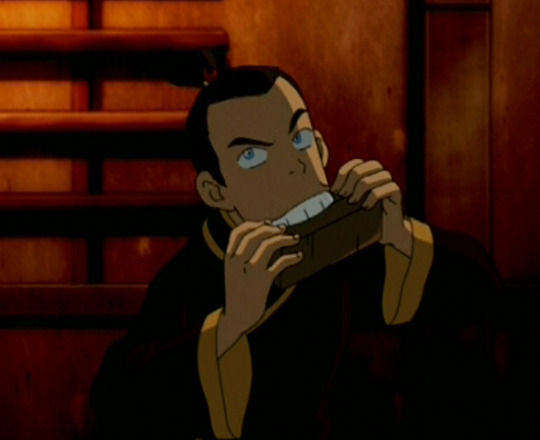
Sokka is so very Sokka this episode.

A reason to live is coming!

*thundering herds of shippers in the distance*
That's clever. The inciting incident gets smelted. Haven't seen that before.
This whole Iroh gets buff montage has been completely dialogue free on Iroh's part. Crazy levels of inner peace, that he'd doesn't need to snark back at the guard.
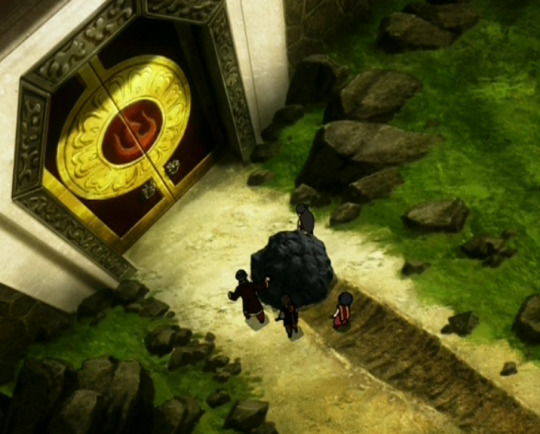
Seriously. What are they FEEDING these children. Also how is that door that shiny.
Sokka really has it in for those door knockers.
Apropos of nothing, the clouds in this episode are all so yummy. All these soft slate colours and misty layers.
Meteoric iron is actually a thing, right?
Ok but aren't mold made swords crappy?

HI YUE
I love how they managed to made a crafting montage where the character who does the least work is the one who looks like he's working the hardest.
"I saw a heart as strong as my garden decor"
"No it certainly wasn't your skills. You had none."
Creativity, versatility, intelligence, meat, sarcasm.
You've known him like two days and you can already tell he's more worthy than any man you've ever trained? Sounds like you had poor taste in students.
"No. This is my fight. Alone." Bro you are going to DIE. The first time you held a sword was two days ago. You might need the avatar on this one.
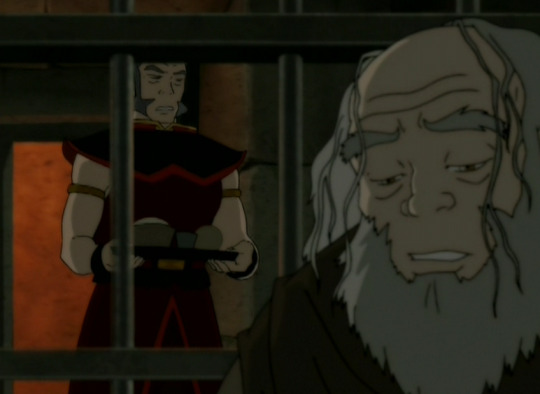
Guard who never shuts up actually kind of has a point here. He's a dick about as usual, but it's entirely possible that the rank and file of the Fire Nation army view Iroh's actions as a betrayal. Does anyone remember in Star Wars movie number 7, or maybe 8, when that Trooper sees Finn after he's switched sides and yells "traitor!" and it's the best part of the movie? Yeah, like that.
This episode throws the concept of linear time out the window. In two days, Iroh gets swole and Sokka masters sword fighting.
Do you think Sokka's realised yet that this is his final exam?
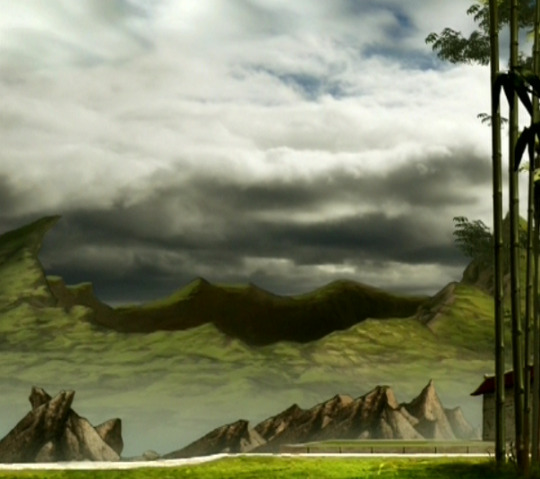
Yummy yummy clouds.
One in a million pocket sand shot.

One in a million stick placement.
So this master is like a sword spirit or something. He can't be human. There's no way he could get the scabbard to fly on perfectly without seeing.
"Try Lee, There's a million Lees. There's a tea shop in Ba Sing Se that has a super cranky waiter called Lee."
This guy's just this side of committing treason and I love it.
I see this Master is a devotee of the 'Hakoda school of shoving outrageously over the top compliments into Sokka's thick skull in the hopes that 1% of them will stick.' I approve.
This last scene has gorgeous hills and skies but you'll have to take my word for it because I've hit the image limit.
Sokka's been inducted into the super secret boy band!!!
He saved space earth for Toph! He's so considerate! He's fuelling the ships!
Let's compromise and call it space dirt instead.
Final Thoughts
This episode every two minutes: Sokka, you are currently flawless and you're about to get better. Me: Yes. Yep. Yeah. Seconded. I concur.
I like it! It's great! It's 24 minutes of the writers and characters fangirling over Sokka! Of course I like it! It made me criminally overuse exclamation marks! What else can I say?
Hands down my favourite episode is Bato of the Water Tribe. For Sokka's story, this episode is Bato of the Water Tribe part 2. Of course I'm going to love it. This episode was lab grown specifically for me.
Now let's see if I can say something about this episode that isn't poorly disguised squealing.
I love how the characters respond to Sokka saying he's not special with an evidence-based refutation rather than blanket reassurance.
I love how shopping cheers up Sokka. I love how Katara knows that shopping will cheer him up. This must be something she's learned since the show started. I don't think there were malls in the South Pole. So Katara was paying attention when Sokka and Momo went through the bag saga.
I love how much the master is baffled yet impressed by Sokka. He seems almost charmed by this breath of fresh air. I think it's hilarious that, when Sokka first approaches him, he's expecting early season 1 Sokka. He'd better send Suki a thank you card.
I also really like "The way of the sword doesn't belong to any one nation." It seems obvious to us, but in a world where there are weaponisable skills that are quite literally inseparable from the nations their wielders inhabit, it's probably something no one in the Gaang has ever heard before.
Obviously the episode is a little rushed - half hour kid's show and all that - but it's still pretty crazy that you can apparently impart a solid basic knowledge of swordplay in two days.
Toph going all tsundere is funny, and makes Aang and Katara unapologetically desperate for Sokka's company twice as funny as it already is. Toph's like "whatever" and the other two spent the day making a welcome home banner.
I love how Sokka's happiness is always so loud and shameless. It makes it contagious.
This episode highlights what Sokka's actual strengths are, by instructing him in what he thinks his strengths are. If that makes sense? Sokka is brain, which he's finally starting to realise by attending brawn lessons.
He's also heart, and I'll die on that hill.
Iroh getting swole was honestly just a thing that happened. No comment really, except it was interesting to have a reminder from the guard that a character we perceive as the good guy is currently perceived as the bad guy by everyone but us. When the Fire Nation does inevitably get defeated, a whole nation is going to have to reset their worldview and that will not be an easy process.
More like this please!
142 notes
·
View notes
Note
What's the difference between a nurse and nurse practitioner?
They are two different "levels" in the nursing hierarchy.
Here's how that hierarchy works in the USA:
At the very beginning rung you have STNAs, or State Tested Nursing Assistants. STNAs have taken a class that lasts in the weeks-months range of time and received a certificate. They have then taken a test to prove that they understand the material. In a job context, STNAs do a lot of the direct patient care- they bathe and feed patients, take vitals, turn patients who cannot move for themselves, etc...
The next rung up is an LPN, or Licensed Practical Nurse. LPNs have gone to a nursing program lasting usually between 1 and 2 years, have received a diploma, and have taken a test called the NCLEX-PN. In a job context, LPNs can do everything an STNA can do, plus they can gather information about a patient's condition, pass medications (except some IV medications) and do many nursing interventions like wound care, placing IVs and catheters, etc... An LPN must work under the license of an RN.
The next rung up is an RN, or Registered Nurse. RNs have either an associates' degree (2-3 years) or a bachelor's degree (4 years) in nursing, which has allowed them to sit for a test called the NCLEX-RN. No matter which education route the nurse takes to get their RN the license is the same and they are allowed to do the same things in a clinical context. In a job context, an RN can do everything an LPN can do, but can give all medications (including IV) and are allowed to also make care decisions LPNs cannot. They also hold an independent license, meaning they can provide nursing level care without needing to be supervised by a higher license-holder.
The next maybe half rung up is a Certified Registered Nurse. These are nurses who have worked in a particular area of nursing (med-surg, psych, ICU, etc...) for a certain number of years and taken classes and a test to say they know a lot about that area of nursing. Now, unlike the nursing license itself, this certification is usually through a private organization instead of the state of practice. Certified Registered Nurses don't have any additional skills they can do, but they do act as a resource for other nurses and may get paid more depending on the organization they work for.
The next rung up is an APRN, or Advanced Practice Registered Nurse. An APRN is a nurse who has a masters degree or higher in nursing, and who, again, has taken a test. Here is where things get complicated. Because 4 different licenses fall under APRN:
Nurse Practitioner (NP). An NP is an APRN who works under a physician's license in some states and hold independent licenses in others. They are able to do a lot of things that doctors can do, including diagnose, treat, and prescribe (what they are able to prescribe depends on the state they are in). NPs specialize in a specific patient population, and they can only work with the type of patient they have specialized in.
Clinical Nurse Specialist (CNS). A CNS is an APRN who acts as a consulting nurse. Basically, they have gotten specific education in a specific area of nursing for a specific population, and they consult with the multidisciplinary team, generally at a hospital, about the nursing care for that type of patient. CNSs typically cannot prescribe medications, but may prescribe nursing interventions.
Certified Registered Nurse Anesthetist (CRNA). A CRNA is an APRN who works as an extension of an anesthesiologist. They provide anesthesia during surgery and procedures.
Certified Nurse Midwife (CNM). A CNM is an APRN who delivers babies and helps mothers and children through the entire maternity and birth process. They may also do things like women's health exams, nutritional counseling, and the like.
55 notes
·
View notes
Note
More questions for you, my friend ✨
9, 20, 43, 66, and 83?
Hello again~ 🥰😘✨
9. in an ideal world where you’re already super successful and published, would you want to see a tv or movie adaptation of your work? why or why not?
Generally, yeah I think so. There are always worries and translation errors and degrees to which I would want to be personally involved, of course. I’d need to sit down and look at each work as a creator and not as a part of my own fandom (as I am now, writing entirely for my own enjoyment) which would have its complications, but LARGELY - I do want to share. It’s why anything is published at all. The exception of course IS Guillermo’s story - it’s all fun and nice to play dolls with, but that cast and those morals were meant to be published. It would need a team of experts to do right and I know that, which is why I tend to publish it less right now and keep it pretty close to my chest, but if I had IP to promote, it would be that.
43. how did writing change you?
This might sound sad, but it’s kind of a natural progression from when I was a kid without many friends. I wasn’t LONELY, mind you, just that I didn’t have friends over or neighbors or cousins my age so I played by myself a lot. Played a lot of pretend. And then when it clicked that thinking of my own plots for my actual dolls could translate into thinking about and then writing down my own plots for other characters (and then -gasp- inserting my OWN little guys into my favorite stories) it was just a whole new world of fun! I think writing keeps me fresh and engaged! Writing means reading, which means consuming new media, so it’s a way to keep the creativity flowing and it fits seamlessly in with my actual art. Being multidisciplinary is important to me, and writing can always fill the gaps when I don’t have time or energy for other stuff.
66. when have you felt the most confident in your writing?
In highschool! @doreenchartreuse and I used to spend hours upon hours RPing back and forth every afternoon and some of those stories were super cliche, sure, but others were honest to god masterpieces that I have carried with me this whole time. It was the start of being able to do it by myself, which like I said, is revolutionary for me.
83. less is more or more is more?
More is more! I will always take more! Subtly is nice and inferring juicy details is fun - I’ll never turn down the anticipation of a sentiment unspoken in a pivotal moment that just drives the tension- but I DO wanna know the sentiment! I WANT to read all about the pretty outfit the LI is wearing and how it fits them and their eye color and the timbre of their voice! Paint me enough pictures to populate a gallery - it is buffet and I am a starving man.
4 notes
·
View notes
Text
Yes many of these are covered in school for 5-18 years, but university courses are taught with more nuance and analysis than courses for younger students.
#polls#poll#daily polls#i love polls#polladay#education#higher education#university#college education#college#liberal studies#liberal arts#multidisciplinary
4 notes
·
View notes
Text

The Echoes of Existence: Biology, Mathematics, and the AI Reflection
The convergence of biology, mathematics, and artificial intelligence (AI) has unveiled a profound nexus, challenging traditional notions of innovation, intelligence, and life. This intersection not only revolutionizes fields like AI development, bio-inspired engineering, and biotechnology but also necessitates a fundamental shift in ethical frameworks and our understanding of the interconnectedness of life and technology. Embracing this convergence, we find that the future of innovation, the redefinition of intelligence, and the evolution of ethical discourse are intricately entwined.
Biological systems, with their inherent creativity and adaptability, set a compelling benchmark for AI. The intricate processes of embryonic development, brain function’s adaptability, and the simplicity yet efficacy of biological algorithms all underscore life’s ingenuity. Replicating this creativity in AI systems challenges developers to mirror not just complexity but innovative prowess, paving the way for breakthroughs in AI, robotics, and biotechnology. This pursuit inherently links technological advancement with a deeper understanding of life’s essence, fostering systems that solve problems with a semblance of life’s own adaptability.
The universal patterns and structures, exemplified by fractals’ self-similar intricacy, highlight the deep connection between biology’s tangible world and mathematics’ abstract realm. This shared architecture implies that patterns are not just emergent but fundamental, inviting a holistic reevaluation of life and intelligence within a broader, universal context. Discovering analogous patterns can enhance technological innovation with more efficient algorithms and refined AI architectures, while also contextualizing life and intelligence in a way that transcends disciplinary silos.
Agency, once presumed exclusive to complex organisms, is now recognized across systems of all complexities, from simple algorithms to intricate biological behaviors. This spectrum necessitates a nuanced AI development approach, incorporating varying degrees of agency for more sophisticated, responsive, and ethically aligned entities. Contextual awareness in human-AI interactions becomes critical, emphasizing the need for ethical evaluations that consider the interplay between creators, creations, and data, thus ensuring harmony in the evolving technological landscape.
Nature’s evolutionary strategy, leveraging existing patterns in a latent space, offers a blueprint for AI development. Emulating this approach can make AI systems more effective, efficient, and creatively intelligent. However, this also demands an ethical framework evolution, particularly with the emergence of quasi-living systems that blur traditional dichotomies. A multidisciplinary dialogue, weaving together philosophy, ethics, biology, and computer science, is crucial for navigating these responsibilities and ensuring technological innovation aligns with societal values.
This convergence redefines our place within the complex web of life and innovation, inviting us to embrace life’s inherent creativity, intelligence, and interconnectedness. By adopting this ethos, we uncover not just novel solutions but also foster a future where technological advancements and human values are intertwined, and the boundaries between life, machine, and intelligence are harmoniously merged, reflecting a deeper, empathetic understanding of our existence within this intricate web.
Self-constructing bodies, collective minds - the intersection of CS, cognitive bio, and philosophy (Michael Levin, November 2024)
youtube
Thursday, November 28, 2024
#ai#biology#math#innovation#tech ethics#biotech#complexity#philosophy of tech#emerging tech#bio-inspired ai#complex systems#presentation#ai assisted writing#machine art#Youtube
8 notes
·
View notes
Text
A relatively new problem in paediatrics is that as technology improves, as we have better early detection and better therapies, more of our patients are surviving to adulthood (which is fantastic!!!) but the adult medical world is woefully underprepared to support these people.
I’ve known so many colleagues with so many stories about how they transitioned someone to adult care who had been doing really well, who then died within a couple months. We care for children until age 16, but many of our kids with chronic and complex conditions we keep until 18/19 in the hospital - and for those with life-limiting conditions some people will continue to see them in clinic until they die.
I don’t think this is individual adult physicians’ fault, but it does show an inability of the system to support adults with disabilities compared to children - it’s harder to get, for example, daily chest physio, good multidisciplinary care, carers at home to the true extent that they are needed. It’s also related to a lack of knowledge, which to some degree is fair - many adult physicians didn’t learn about cerebral palsy, or many of the epilepsy or genetic syndromes, because those people just didn’t live to see an adult neurologist in the past.
However, this is no excuse. The world has changed for the better, people who used to die at 5 are reaching adulthood! But the medical world needs to adapt and improve and make room so that these gains can continue well into adulthood.
The world isn’t kind to anyone with disabilities, but particularly to adults. The lack of support is egregious but, in my opinion, fixable.
#medblr#pediatrics#paediatrics#sorry for the rant we had a rehab lecture today and it reminded me of some of the really lovely kids i’ve met#and the comparison to the adults i met back when i worked in an adult ED#And just the massive difference in support#not that paeds is perfect!!!! many things we could improve on#and i know all specialties are improving all the time
6 notes
·
View notes
Text
“On Monday, the biotechnology company Colossal Biosciences revealed, with much fanfare, that they have created a trio of white wolf hybrids. Named Romulus, Remus, and Khaleesi, these wolves, Colossal says, were created by making 20 edits on 14 gray wolf genes. These were used to generate hybrid cell lines that were placed in donor eggs, carried to term by domestic dogs. Four pups were born, one of which died. The surviving three now run around a 2,000-acre private facility in the United States where they are “continuously monitored.” It seems that the wolves may never know life outside some kind of confinement.
The company calls these creatures dire wolves, claiming to have brought the species Aenocyon dirus back from extinction. Exactly what Colossal accomplished, however, is opaque. The private company did not publish a scientific, peer-reviewed paper along with its media blitz—there was a flurry of credulous articles that I’m sure you’ve seen on your news feeds—though they promise that a paper is coming next week. A spokesperson told Slate on Wednesday afternoon that the paper has been submitted for peer review, and a preprint version “is being submitted” and should be posted in a day or two. For now, we have precious little to go on outside of the company’s own claims.
(…)
First, dire wolves and gray wolves, like the ones whose genes Colossal modified, evolved independently from each other over millions of years, though the exact degree to which they are related might depend on whom you ask. In 2021 a multidisciplinary group of researchers found that fossil dire wolves, like those found by the thousands in L.A.’s La Brea asphalt seep, were not closely related to the wolves that roam our planet today. Dire wolves appeared to be descendants of an older line of canids (the larger family that includes everything from domestic dogs to foxes) that split off from other canids about 5 million years ago. Though they are genetically closer to jackals, they convergently evolved to resemble gray wolves. The skeletal resemblance can be close enough that even experts sometimes have difficulty properly identifying a dire wolf fossil from a prehistoric gray wolf one. When dire wolves went extinct about 10,000 years ago, gray wolves became more numerous and expanded to fill the niches dire wolves left open.
That’s the current thinking, anyway—as with anything in science, new evidence can change things. Now, Colossal’s own researchers have claimed to journalists that their research has again adjusted the picture, proposing that dire wolves arose from interbreeding between two different wolf lineages between 2.5 million and 3.5 million years ago. This would put them a bit closer to gray wolves. It will be useful to see their reasoning for this shift outlined in a scientific paper, in a format where their techniques can be critiqued by other experts, which is a crucial part of scientific research. But even so, it’s hard to imagine that even a “mere” 2.5 million years of evolutionary change can be captured by 20 gene edits. (According to a statement from Colossal Biosciences sent to Slate, the company aimed “to resurrect the key traits that defined dire wolves.” Its team stopped at 20 edits“[b]ecause we didn’t need more” and because every edit poses some risk to the goal of birthing a health animal.)
Then there’s the Biology 101 fact that an organism is not just its genome. Even if Colossal did make a wolf with a complete Aenocyon dirus genome, those genes would not dictate every choice and every behavior of the creatures they belonged to. The reality is that genes interact with environments, and organisms emerge from the interplay from the two. We know from the fossil record that dire wolves were social creatures, but we’re too late to observe exactly how each generation of pups learned skills from the one before it. Romulus, Remus, and Khaleesi do not have dire wolf parents to learn from—and we have absolutely no way of knowing whether they are truly behaving like dire wolves at all.
(…)
What we’re really looking at, it seems, are gray wolves modified to be dire wolves of George R.R. Martin’s books rather than living, breathing replicas of the actual prehistoric carnivores that hunted bison, horses, camels, and baby mammoths in packs during the Pleistocene. They look like the animal actors on the HBO adaptation of Game of Thrones. Given that Martin is both an investor in and adviser to Colossal, it feels awfully convenient that the company is heavily promoting wolves that are the spitting image of those in his fantasy series. The canids might be “dire wolves” in the fictional sense, but they are not literally dire wolves. Romulus, Remus, and Khaleesi are, at best, a shaky hypothesis of what dire wolves might have looked like. As creatures that were created by modifying modern organisms, and who live in modern times, they are untethered from the evolutionary history embodied by the real dire wolves who now rest in the fossil record. Sure, Colossal has, perhaps, done something here. But Colossal’s wolves are not dire wolves, and they never will be. “As one of our founders stated, ‘this is the moon landing of synthetic biology,’ ” Colossal told Slate in a statement. But the fact is that gene editing can’t reconnect the social lives and ecological roles of animals that have been extinct for thousands of years. Trying to “bring back” dire wolves by modifying gray wolves is like saying you can reach the moon if you jump really high on a trampoline. Maybe you can get an inch closer than you could before. Maybe you can put the trampoline on a platform, too. But you’ll never arrive.
To put it another way, Colossal’s dire wolves are like Tesla’s disastrous Cybertruck. I don’t think it’s a coincidence that the co-founder of Colossal is a billionaire. Someone rich felt a pang of nostalgia and made a demand. The infamous and ugly Cybertruck was inspired by video game vehicles. Colossal’s wolves are prestige TV creatures. This kind of thinking is everywhere: Blue Origin is sending Katy Perry way high up into the sky, a stunt to help sell a sci-fi daydream of one day taking a bus to Moon. This isn’t progress; it’s a bunch of toys. Meanwhile, the government is actively gutting science and health agencies, and firing people who do the challenging and often-unglamourous work that research involves—not for personal glory and a shiny press treatment, but simply to advance knowledge and make the world better for the humans and creatures who already live here. Careful and painstaking conservation work, such as the work restoring wood bison herds to Alaska, is overlooked in favor of designer species given meme-sprinkled promo reels.
Facts, as we have bitterly learned over the past two decades, count for little right now. Colossal’s very questionable marketing of its genetic tinkering has already prompted Donald Trump’s oil-friendly Secretary of the Interior Doug Burgum to insinuate that the endangered species list will be a thing of the past if we can just refresh and resurrect species at will. “[T]he status quo is focused on regulation more than innovation,” he posted on X. To say Colossal is the future of conservation is to task the offensively wealthy with deciding the future of life on Earth. Any number of environmental injuries and insults can be justified if we believe that everything can be placed back how it was with a little innovation. Looking at Colossal’s wolves, I don’t even feel a “wow” moment like Ellie Sattler had spotting an InGen-made Brachiosaurus in Jurassic Park. I hurt for these wolves, creatures wholly unaware that they were created to be trophies.”
5 notes
·
View notes
Text
Understanding Hirsutism: How PCOS Affects Hair Growth
Hello again, and welcome back to Shining Through PCOS! Today we’re continuing a topic that resonates deeply with many of us living with Polycystic Ovarian Syndrome (PCOS)—hirsutism—and how our hormone imbalances contribute to this challenging symptom.
The Hormonal Connection to Hirsutism
Hirsutism, the growth of coarse, dark hair in areas where men typically grow hair, is one of the most distressing symptoms of PCOS. While it’s not uncommon for women to experience unwanted hair growth at some point, for those of us with PCOS, it often feels like a relentless battle against our own bodies. Understanding the underlying hormonal imbalances can help us navigate this challenge with more compassion for ourselves.
Previously, we discussed how some of the conditions we deal with as a result of PCOS overlap. At the heart of hirsutism in women with PCOS are elevated levels of androgens, often referred to as “male hormones.” While everyone has these hormones to some degree, women with PCOS typically have higher-than-normal levels (Rizvi et al., 2023). This hormonal imbalance is primarily due to something called insulin resistance, a condition where the body’s cells become less responsive to insulin, leading to higher levels within the bloodstream (Barber et al., 2019). Elevated insulin can stimulate the ovaries to produce more androgens, which in turn contributes to symptoms like hirsutism, acne, and irregularities in ovulation (Rosenfield & Ehrmann, 2016).
Understanding the Role of Androgens
Androgens play a crucial role in hair growth, but not in the way we might hope. In women with PCOS, the overproduction of hormones like testosterone can lead to the development of male-pattern hair growth (Mihailidis et al., 2015). Common areas for hirsutism include the face, chest, and back, making it a source of significant emotional distress for many of us (Mihailidis et al., 2015).
I remember grappling with so much embarrassment over the abundance of body hair I dealt with as a child. I felt perpetually frustrated and humiliated in my own skin. It’s a tough battle to handle feelings of inadequacy, especially at a young age when you’re not only worried about your self-perception but also how others perceive you. Many people may tell you it’s “just body hair,” but they underestimate the toll it can take. It affects how you perceive yourself, deprives you of your femininity, and impacts your ability to relate to others and feel a sense of normalcy and autonomy. It’s so much more than just hair.
For many women, including myself, it goes beyond mere appearance; it’s about how we feel in our skin. The pressure to meet certain beauty ideals can lead to feelings of shame and isolation, particularly in visible areas where hair growth can’t be ignored. It's vital to remember that these feelings are valid, and seeking support—whether through friends, family, or professional help—can be an important step in managing the emotional toll of PCOS.
Finding Hope in Treatment Options
While hirsutism can be a challenging aspect of living with PCOS, the good news is that effective treatment options are available. Laser-Based Hair Reduction (LBHR) has emerged as a popular choice for many women looking to manage excess hair growth. However, it’s essential to remember that LBHR targets the symptoms, not the underlying hormonal imbalance. Combining this treatment with lifestyle changes and, in some cases, medications like anti-androgens can create a more comprehensive approach to managing hirsutism (Narang et al., 2018).
As a student dermal clinician, I believe it is crucial for service providers to be as transparent as possible. While LBHR is an excellent treatment for addressing the rate of hair growth, length, and density, it is not a simple fix. It becomes even more complex with how LBHR is marketed as “permanent removal” when it is, in fact, “permanent reduction.” This requires a multidisciplinary approach, which can be a lengthy process. Providers must understand when a client needs this comprehensive approach and when to refer patients for aspects of a condition that may be outside our scope of practice.
Unfortunately, patients are often taken in without understanding the complexity of their condition and are not encouraged to seek medical advice regarding their hormonal levels. It’s essential for providers to discuss all aspects of PCOS instead of offering LBHR as a mere band-aid solution.
In future posts, we’ll delve deeper into these treatment options, discussing their benefits and limitations while emphasising the importance of a tailored approach for each individual.
L ᥫ᭡
References
Mihailidis, J., Dermesropian, R., Taxel, P., Luthra, P., & Grant-Kels, J. M. (2015). Endocrine evaluation of hirsutism. International Journal of Women's Dermatology, 1(2), 90-94. https://doi.org/10.1016/j.ijwd.2015.04.003
Narang, G. S., Jasleen, J., Kaur, J., & Kaur, T. (2018). Cutis vertices gyrate: A case report. International Journal of Contemporary Pediatrics, 5(4), 1693. https://doi.org/10.18203/2349-3291.ijcp20182592
Rizvi, M., Islam, M. A., Aftab, M. T., Naqvi, A. A., Jahangir, A., Ishaqui, A. A., Iqbal, M. Z., & Iqbal, M. S. (2023). Knowledge, attitude, and perceptions about polycystic ovarian syndrome, and its determinants among Pakistani undergraduate students. PLOS ONE, 18(5), e0285284. https://doi.org/10.1371/journal.pone.0285284
Rosenfield, R. L., & Ehrmann, D. A. (2016). The pathogenesis of polycystic ovary syndrome (PCOS): The hypothesis of PCOS as functional ovarian hyperandrogenism revisited. Endocrine Reviews, 37(5), 467-520. https://doi.org/10.1210/er.2015-1104
7 notes
·
View notes
Text
Unlocking a Healthier Future: A Deep Dive into the Master of Public Health Course
In today’s rapidly evolving global health landscape, the Master of Public Health (MPH) course plays a pivotal role in shaping professionals who can lead systemic change. At SIHS (School of Integrated Health Sciences), the SIHS MPH has been meticulously crafted to equip students with extensive knowledge and practical skills necessary to tackle public health challenges across communities.
Why Choose the MPH at SIHS?
SIHS’s MPH program is designed with a multidisciplinary approach, ensuring that students gain expertise in epidemiology, biostatistics, health policy, environmental health, and health systems management. By accessing Master of Public Health Course, prospective students can explore the program's holistic curriculum highlighting both theoretical foundations and immersive fieldwork.
What sets this MPH course apart is its commitment to experiential learning. Through real-world projects, internships, and community outreach, students not only grasp public health concepts but also apply them in practical settings. This hands-on model cultivates essential leadership skills, data-driven analytical thinking, and adaptability qualities in high demand by governmental bodies, non-profits, healthcare agencies, and international organizations.
Curriculum Highlights
The structure of the Master of Public Health Course ensures a well-rounded education:
Core Foundations: Epidemiology, Biostatistics, Environmental Health, Social and Behavioral Sciences
Policy & Management: Health Policies, Program Planning, Health System Governance
Field Practicum: Community-based projects and internships
Capstone Project: Addressing a pressing public health issue with research-backed solutions
This meticulous blend empowers graduates to emerge as competent public health strategists with the capacity to innovate, plan, and implement sustainable health initiatives in diverse environments.
Career Pathways and Impact
Graduates from SIHS’s MPH program are fully prepared to step into roles such as Epidemiologists, Health Policy Analysts, Public Health Consultants, and Program Directors. Professionals who complete the MPH often take on leadership positions in health departments, NGOs, the World Health Organization, and research institutions.
The skills honed through Master of Public Health (MPH) extend far beyond professional success. MPH alumni carry forward a deep sense of social responsibility, equipped to battle health disparities, champion preventive care, and respond effectively to public health crises.
Student Support and Aspirations
SIHS fosters a supportive learning environment, offering mentorship from seasoned faculty, networking opportunities, career services, and access to cutting-edge research facilities. Students benefit from guidance tailored toward personal development and professional advancement, combining academic rigor with accessible support systems.
Final Thoughts
The Master of Public Health course at SIHS explore more at https://www.sihs.edu.in/master-of-public-health-course is more than a degree; it’s a gateway to meaningful change. For those driven by a vision of healthier communities and a stronger public health infrastructure, this MPH program is a transformative journey empowering learners to become leaders in the global quest for wellness and equity.
Embark on this life-changing academic venture and be a catalyst for positive health impact begin your MPH journey with SIHS today!
2 notes
·
View notes
Text
Just learned my dads military benefits wont pay for these two classes i need bc they arent part of my degree plan even though they technically are bc i need them to get into the program but bc im not in the program yet im just under multidisciplinary and not the actual program so therefore jts not oart of my degree plan and i have to pay for the class in two days 😃
4 notes
·
View notes
Text
Movement
07/03/25
Final Thoughts:
I enjoyed the movement project, coming up with ideas, and dealing with a subject matter that challenged me (panic attacks).
It was very interesting to get involved with my choice electives of painting, printmaking and ceramics and I learned a lot about each principle. I was surprised at which disciplines I ended up being more successful in, and I particularly enjoyed and engaged mostly with ceramics and painting, even though in my spare time I’ve had more success with print this wasn’t the case for this project. This allowed me to look at what I might need to improve in the future. I learned some new techniques and skills such as painting on a bigger scale than before and glazing ceramics which I would like to build on in the future.
I found that connecting all of the pieces together allowed me to explore ideas as they flowed naturally, on reflection I could have probably pushed to combine the disciplines even more into singular pieces and in hindsight I would push myself to do that more if I did the project again but found that allowing them to flow into each other helped me come up with more ideas and themes. I am particularly happy with the last painting I finished and the ceramic pieces I made as I think these were the most successful not only technically but also how they tie into each other and work together form a story.
Overall I am not happy with all of the work I produced as a lot of it felt rushed and I was confused at times, I also think that the heavy subject matter got to me at times which is something I will be more careful of in the future, however, all together the pieces carry the theme of panic attacks and get a point across to a degree.
The process of producing the body of work itself was more successful than the pieces I think for the most part because this enabled me to think in new ways and across a variety of disciplines and techniques each inspiring the next and this multidisciplinary approach is something I will definitely consider in the future.
2 notes
·
View notes
Text
Anyone with a Masters degree in materials engineering (or potentially related field) background looking for a PhD scholarship in New Zealand? I'm about to post this on my work LinkedIn...
PhD scholarship – Large format 3D printing with biocomposites
Background: We have a fully-funded PhD scholarship as part of the MBIE Endeavour project “Āmiomio Aotearoa: A Circular Economy for the Wellbeing of New Zealand”. The project is a collaboration between universities, research institutes, industry, community groups and government ministries hosted by the School of Engineering at Waikato University. It aims to pave the way through materials science, engineering, energy, economics, kaupapa Māori, business, law and regulation, social science and public policy for a more sustainable New Zealand.
As a PhD student at the University of Waikato, you would be focused on advancing sustainable manufacturing practices through the development and application of biocomposites.
The successful candidate will explore the use of biopolymers, recycled thermoplastics, and natural fibres to formulate high-performance biocomposites suitable for large format 3D printing (furniture, small structures, interior design). The research will delve into multiple aspects of these materials, including their performance, printability, design optimisation, and life cycle assessment.
This interdisciplinary project provides a unique opportunity to contribute to cutting-edge research at the intersection of materials science, environmental sustainability, and advanced manufacturing technologies. We invite passionate and driven individuals to join our team and contribute to this transformative research endeavour.
Your ideal background:
MSc/ME in a related Science/Engineering discipline
experience with natural materials
familiar with CAD design and 3D printing is a plus
experience in life cycle assessment is a plus
a willingness to learn, up-skill and work in multidisciplinary group
a professional attitude, good writing and time management skills
resilience to take on the challenge of the research experience
Value: a stipend of NZ$30,000 per year, domestic tuition fees and insurance, and support for research materials.
Application documents required
CV including contact details for 2-3 referees (including at least one academic reference)
Academic transcript from previous study undertaken (and thesis if available/applicable)
A personal statement (max 1 page) describing your motivation, interests and background related to the research project
English language Certificate where English is not the first language (IELTS/TOEFL)
LINKEDIN for contact details of the guy and you can see he's got the scholarship listed as well.
7 notes
·
View notes
Text


Together with his brother Rudolf, Heinz Wäger counts among the major exponents of postwar architecture in the state of Vorarlberg, Austria. But in contrast to his brother, who was an autodidact, Heinz Wäger in 1963 obtained a degree from the legendary Hochschule für Gestaltung in Ulm. The school’s multidisciplinary approach had a lasting impact on Wäger’s oeuvre since he didn’t limit himself to architecture alone but also designed furniture, sculpted and painted in his pastime. Beyond this multidisciplinary thinking the HfG instilled an analytical approach to every project as well as an international orientation in Wäger that especially shows in his architecture and design: with the house for his parents, realized between 1960 and 1962 in collaboration with his brothers Rudolf and Siegfried, Wäger introduced a simple elegance reminiscent of the Case Study Houses in Vorarlberg. At the same time he also designed a number of industrial buildings characterized by great formal consistency paired with highest functional standards. In 1971 Heinz Wäger once again teamed up with his brothers in the planning company „Coparts“: oriented on the HfG Ulm the collective bundled architecture, visual communication and graphic design and consecutively realized a row-house estate, industrial buildings and the reorganization of the hospital in Hohenems. Unfortunately the collective failed due to human incompetences.
Based on Heinz Wäger's archive at Vorarlberg Museum a publication finally provides an overview of his multifaceted oeuvre: „Heinz Wäger - Einblick in 60 Jahre Gestaltung. Architektur, Design, Objekt“, published earlier this year by Verlag für Moderne Kunst, in a small but substantial and creatively designed volume brings together life and work of the architect. In a long interview Wäger reflects on his formative years at the HfG while architectural historian recounts the development of his architecture and situates it within Vorarlberg and the international context. Together with the comprehensive reproduction of Wäger’s key works the small book provides a substantial overview of the career of a pivotal protagonist of Austrian postwar architecture. Highly recommended!
14 notes
·
View notes
Text
Science and Nature - A One Health Perspective
With an open-ended blog prompt this week, I wanted to reflect on my evolving understanding of science as a means to understand our world’s issues. Science has always been an interest of mine. I’d always thought science was the key to understanding the world’s complex problems that we always hear about. Climate change, health crises, food insecurity, poverty, deforestation; I thought these issues could be solved with the proper understanding and application of science. We just needed to find those answers, and we needed scientific knowledge to do so.
I’m currently majoring in One Health, and by now, I have a good understanding of how interconnected human, animal, and environmental health truly are. Because of this, as much as I value science, I’ve also learned to recognize its limitations. The environmental crises we face today—from climate change to biodiversity loss—cannot be solved by scientific knowledge alone. We need holistic, multidisciplinary solutions that integrate different perspectives, including social, cultural, and ethical dimensions.
Of course, science provides essential tools for understanding and addressing environmental issues. It helps us monitor pollution, assess biodiversity loss, and develop conservation strategies. However, science often focuses on facts, data, and technological solutions, assuming that if people have the right information, they will act accordingly. Research on environmental education (EE) challenges this assumption, suggesting that people’s actions are influenced by broader worldviews, social structures, and belief systems—not just scientific facts (Wals et al., 2014). This pattern can be seen everywhere, and if you ask me, the state of the environment today makes this a more pressing issue than ever before. Ecosystems are collapsing, biodiversity is declining, and communities are facing worsening climate disasters and human health crises, yet many people—even those who hold an immense amount of power and influence in today’s society—refuse to accept and feel responsible for these crises because of the values they already hold. This means that simply presenting climate data to skeptics won’t necessarily change their minds, and as you can imagine, this makes it very difficult to instill lasting, sustainable change to mitigate these issues.
As I’ve learned throughout my degree, the most powerful way to ignite change is not just through facts and figures, but through shared values, storytelling, and hands-on experiences. One Health is an interdisciplinary field that recognizes the deep, inescapable ties between humans, animals, and the environment, embracing both scientific and non-scientific approaches to solving the world’s most pressing challenges. Take environmental education and citizen science, for example. These programs don’t just teach people about conservation; they invite them to be a part of it. They foster a sense of belonging, connection, and responsibility—transforming passive observers into active advocates of the world around them (Wals et al., 2014).
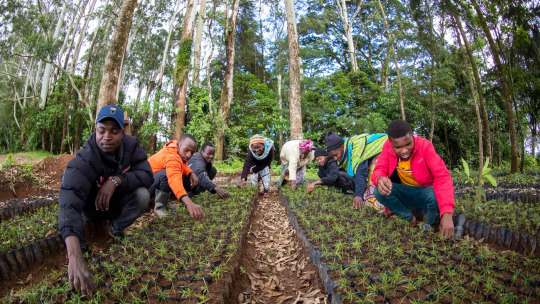
An example: Farmers planting trees in Tsavo, Kenya (IFAW, 2023)
I also believe in the undeniable power of early experiences in nature. Young people are the future of the planet, and if they grow up not only understanding nature but truly feeling a part of it, their love for the earth will shape the way they walk through the world. It will spark inspiration, curiosity, and ultimately, change. I’d like to end this post with a quote, which I think perfectly embodies the importance of education to inspire connection to nature:
“In the end, we will conserve only what we love; we will love only what we understand; and we will understand only what we are taught.” – Baba Dioum, Senegalese forestry engineer, 1968 in New Delhi at the General Assembly of the IUCN.
If we want a better future, we must start by inspiring the hearts and minds of those who will create it.
References:
Wals et al. (2014). Convergence between science and environmental education. Science, 344(6184), 583-584. https://doi.org/10.1126/science.1250515
International Fund for Animal Welfare (IFAW). (2023). Planting trees to safeguard elephant habitats in Tsavo, Kenya. https://www.ifaw.org/journal/planting-trees-elephant-habitats-tsavo
2 notes
·
View notes